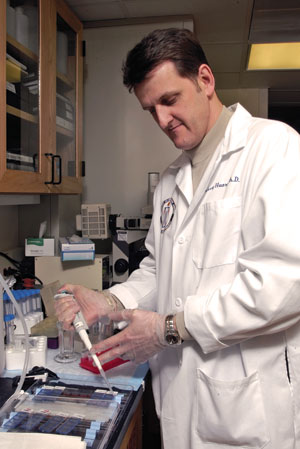Pitt, Children’s Researchers Use Novel Stem Cells to Repair Injured Heart Muscles in Mice

Researchers at the University of Pittsburgh and Children’s Hospital of Pittsburgh of UPMC have been able to effectively repair damaged heart muscle in an animal model using a novel population of stem cells they discovered that is derived from human skeletal muscle tissue.
The research team at Children’s Hospital is led by Johnny Huard, a professor in the University of Pittsburgh School of Medicine’s Departments of Orthopaedic Surgery, Molecular Genetics, Biochemistry, Bioengineering, and Pathology. He is also the Henry J. Mankin Professor and vice chair for research in the Department of Orthopaedic Surgery.
Huard transplanted stem cells purified from human muscle-derived blood vessels into the hearts of mice that had heart damage similar to that which would occur in people who had suffered a heart attack.
These transplanted myoendothelial cells repaired the injured muscle, stimulated the growth of new blood vessels in the heart, and reduced scar tissue from the injury, thereby dramatically improving the function of the injured left ventricle, said Huard, director of the Stem Cell Research Center in Children’s Hospital’s John G. Rangos Sr. Research Center.
“This study confirms our belief that this novel population of stem cells discovered in our laboratory holds tremendous promise for the future of regenerative medicine. Specifically, myoendothelial cells show potential as a therapy for people who have suffered a myocardial infarction,” said Huard. “The important benefit of our approach is that as a therapy, it could be an autologous transplant. This means that for a patient who suffers a heart attack, we would take a muscle biopsy from his or her muscle, isolate and purify the myoendothelial cells, and reinject them into the injured heart muscle, thereby avoiding any risk of rejection by introducing foreign cells.”
Results of the study were published in the Journal of the American College of Cardiology.
The myoendothelial cells used in this study were more effective at repairing the injured cardiac muscle and reducing scar tissue than previous approaches that have used muscle cells known as myoblasts, according to Huard. At six weeks after injection, the myoendothelial cell-injected hearts functioned 40 to 50 percent more effectively compared with hearts that had been injected with myogenic cells (myoblasts).
Huard and colleagues in the Stem Cell Research Center are researching and developing numerous therapeutic uses for the population of muscle stem cells that the team identified. One of the most promising uses could be for the treatment of Duchenne muscular dystrophy (DMD), a genetic disease that affects one in every 3,500 boys. Patients with DMD lack dystrophin, a protein that gives muscle cells structure.
Huard is an internationally recognized cell biologist conducting laboratory research into the therapeutic use of stem cells to treat a variety of musculoskeletal and orthopaedic diseases and injuries. In the lab, Huard is developing cutting-edge therapies to regenerate bone, cartilage, and peripheral nerve and to repair damaged skeletal muscle after sports and military injuries.
Other Stories From This Issue
On the Freedom Road

Follow a group of Pitt students on the Returning to the Roots of Civil Rights bus tour, a nine-day, 2,300-mile journey crisscrossing five states.
Day 1: The Awakening
Day 2: Deep Impressions
Day 3: Music, Montgomery, and More
Day 4: Looking Back, Looking Forward
Day 5: Learning to Remember
Day 6: The Mountaintop
Day 7: Slavery and Beyond
Day 8: Lessons to Bring Home
Day 9: Final Lessons

